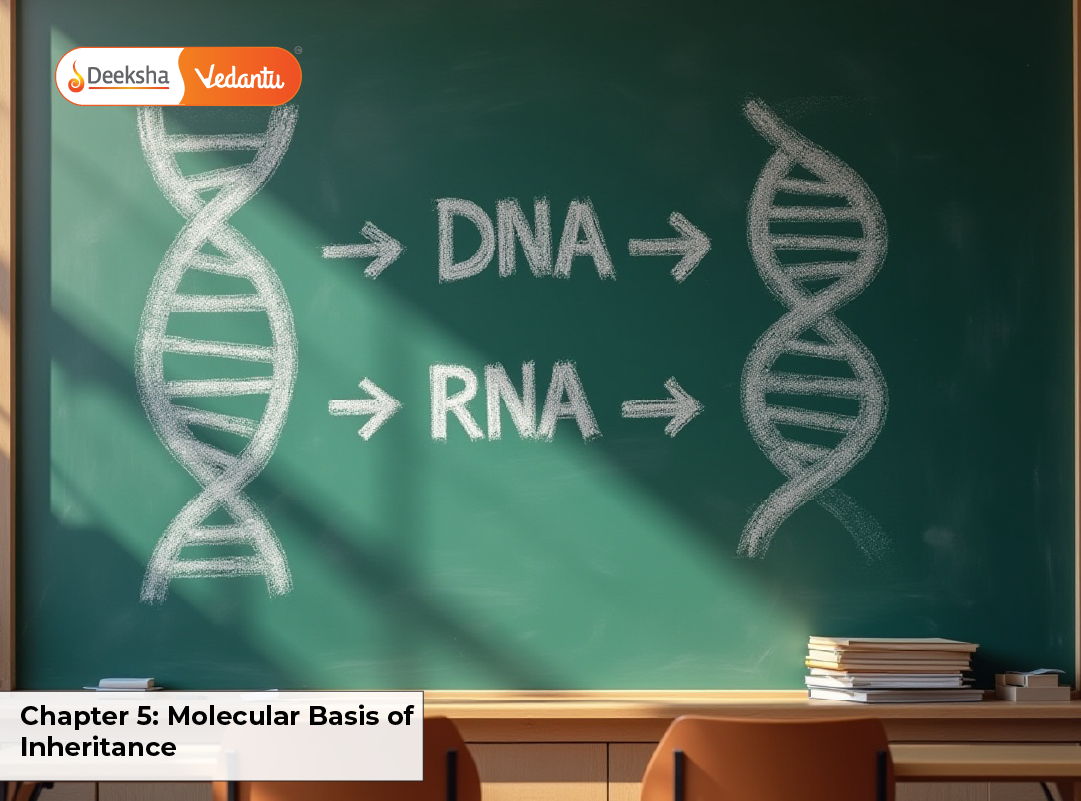The Molecular Basis of Inheritance forms one of the most crucial pillars in understanding the functioning of life at the molecular level. For NEET aspirants, mastering this chapter is vital, as it lays the groundwork for comprehending how hereditary material is transmitted, expressed, and regulated in living organisms. The chapter encapsulates the molecular mechanisms that define genetics and heredity, central dogma, the structural details of DNA and RNA, and how these molecules orchestrate cellular functions. Furthermore, the chapter introduces key biotechnological techniques that have revolutionized molecular biology research.
Let’s now explore each major concept outlined in this chapter in rich detail, focusing on how it relates to NEET preparation and real-world biological applications.
Key Topics and Concepts:
1. DNA Structure and Function
- DNA (Deoxyribonucleic Acid) is a polymer composed of repeating units called nucleotides.
- Each nucleotide is made of three components: a deoxyribose sugar, a phosphate group, and a nitrogenous base.
- There are four nitrogenous bases: Adenine (A), Thymine (T), Cytosine (C), and Guanine (G).
- Adenine pairs with Thymine via two hydrogen bonds; Cytosine pairs with Guanine via three hydrogen bonds.
- The double-helix structure proposed by Watson and Crick explains how genetic information is stored and replicated.
- DNA is usually found in the B-form, which is a right-handed helix, but A-form and Z-form may occur under specific conditions.
- The antiparallel orientation of the strands is critical to the molecule’s stability and function.
2. Packaging of DNA
- Human DNA comprises approximately 3 billion base pairs, which need to be compacted to fit inside the nucleus.
- In eukaryotic cells, DNA wraps around histone proteins forming structures called nucleosomes.
- Nucleosomes resemble beads on a string and further coil into solenoids and supercoils to form chromatin.
- Chromatin can be transcriptionally active (euchromatin) or inactive (heterochromatin).
- This dynamic structure allows access to genes for transcription while maintaining genomic stability.
3. DNA Replication
- DNA replication is semi-conservative, meaning each new DNA molecule consists of one parental and one newly synthesized strand.
- This process begins at the origins of replication, creating replication forks.
- Key enzymes and their functions:
- Helicase unwinds the DNA double helix.
- Primase synthesizes a short RNA primer.
- DNA Polymerase extends the new strand by adding nucleotides.
- Ligase seals the nicks between Okazaki fragments.
- Topoisomerase relieves supercoiling stress.
- The leading strand is synthesized continuously, while the lagging strand is built in fragments.
- DNA Polymerase has proofreading abilities, ensuring high fidelity during replication.
- In eukaryotes, multiple origins speed up the replication of large genomes.
4. Transcription (DNA to RNA)
- Transcription is the process by which an RNA strand is synthesized using DNA as a template.
- Occurs in three stages:
- Initiation: RNA Polymerase binds to the promoter region and unwinds DNA.
- Elongation: RNA nucleotides are added complementary to the DNA template strand.
- Termination: Transcription ends upon reaching a terminator sequence.
- In prokaryotes, a single RNA polymerase is involved, whereas in eukaryotes, RNA polymerases I, II, and III perform specific roles.
- Post-transcriptional modifications (only in eukaryotes) include:
- 5′ capping
- Polyadenylation (Poly-A tail)
- Splicing of introns
5. Genetic Code
- The genetic code is the set of rules by which the information encoded in mRNA is translated into proteins.
- Characteristics:
- Triplet code: Each amino acid is encoded by a group of 3 nucleotides (codon).
- Degenerate: Multiple codons can specify the same amino acid.
- Non-overlapping and comma-less.
- Universal (with a few exceptions).
- Start codon: AUG (methionine)
- Stop codons: UAA, UAG, UGA
- The code ensures accurate transmission of information from mRNA to polypeptides.
6. Translation (RNA to Protein)
- Translation is the process of synthesizing proteins from mRNA.
- Occurs on ribosomes in the cytoplasm.
- Components involved:
- mRNA: Carries codon sequence.
- tRNA: Delivers specific amino acids.
- rRNA: Structural and catalytic part of ribosomes.
- Steps:
- Initiation: Ribosome binds to mRNA and initiator tRNA pairs with start codon.
- Elongation: Sequential addition of amino acids.
- Termination: Occurs when a stop codon is reached.
- Example: Translation of insulin mRNA results in the synthesis of insulin protein.
7. Regulation of Gene Expression
- Gene regulation is essential for cell specialization and adaptation.
- In prokaryotes, the Lac Operon is a classical example:
- Inducible system regulated by the presence of lactose.
- In the absence of lactose, a repressor binds to the operator, blocking transcription.
- When lactose is present, it binds to the repressor, inactivating it and allowing transcription.
- In eukaryotes, regulation is more complex, involving enhancers, silencers, transcription factors, and epigenetic mechanisms.
8. Human Genome Project (HGP)
- International research initiative to map the entire human genome.
- Completed in 2003, identifying over 20,000 genes and 3.3 billion base pairs.
- Goals:
- Determine the sequence of DNA.
- Identify genes and their functions.
- Store information in databases.
- Improve diagnostics and treatment of diseases.
- Applications:
- Personalized medicine
- Gene therapy
- Evolutionary studies
- DNA sequencing technologies
9. DNA Fingerprinting
- DNA fingerprinting involves comparing DNA samples to establish identity.
- Based on unique patterns in Variable Number Tandem Repeats (VNTRs).
- Developed by Alec Jeffreys in 1985.
- Applications:
- Criminal investigations
- Paternity and maternity tests
- Genetic relationship studies
- Identification of remains
Practice MCQs for NEET:
- Which enzyme is responsible for joining Okazaki fragments?
- Answer: Ligase
- What is the start codon in most organisms?
- Answer: AUG
- What is the key enzyme involved in transcription?
- Answer: RNA Polymerase
- The semi-conservative model of replication was proved by:
- Answer: Meselson and Stahl
- Which of the following is a stop codon?
- Answer: UAG
- What does the Lac Operon control?
- Answer: Lactose metabolism
- VNTRs are used in:
- Answer: DNA Fingerprinting
- Which molecule acts as an adapter in translation?
- Answer: tRNA
- Which enzyme initiates DNA synthesis by adding RNA primers?
- Answer: Primase
- What is the role of topoisomerase in DNA replication?
- Answer: It prevents supercoiling.
FAQs:
Q1. What is the difference between DNA and RNA?
DNA has deoxyribose sugar and uses thymine; RNA has ribose and uses uracil instead of thymine.
Q2. What is the Central Dogma of molecular biology?
It describes the flow of genetic information: DNA → RNA → Protein.
Q3. Why is the genetic code said to be degenerate?
Because multiple codons can code for the same amino acid, reducing the impact of point mutations.
Q4. What is the importance of the Human Genome Project?
It provided a complete blueprint of the human genome, enabling gene therapy, personalized medicine, and predictive diagnostics.
Q5. What are Okazaki fragments?
Short DNA fragments synthesized on the lagging strand during replication due to the 5’ to 3’ directionality of DNA polymerase.
Q6. What are exons and introns?
Exons are coding regions that remain in mRNA; introns are removed during RNA splicing.
Q7. How do mutations affect gene expression?
Mutations can alter protein structure or function, influence regulatory sequences, or introduce premature stop codons.
Q8. What is RNA splicing?
RNA splicing is the removal of introns and joining of exons in pre-mRNA to form mature mRNA in eukaryotes.
Q9. Why is DNA replication called semi-conservative?
Each daughter’s DNA contains one strand from the parent and one newly synthesized strand, ensuring genetic continuity.
NEET Tips:
- Read the NCERT textbook thoroughly—most NEET Biology questions are taken directly from NCERT lines.
- Practice labeled diagrams for DNA structure, transcription, translation, Lac Operon, and DNA replication.
- Solve NEET-based MCQs after completing each sub-topic.
- Use concept-mapping and flashcards to remember key enzymes and codons.
- Review frequently asked questions and previous years’ NEET papers.
Conclusion:
The Molecular Basis of Inheritance lays the foundation for understanding advanced topics in biology and medicine. With the progression from DNA to RNA to proteins, this chapter encapsulates life’s blueprint and execution. A solid grasp of DNA structure, replication, transcription, translation, and gene regulation equips NEET aspirants with essential knowledge to handle application-based and conceptual questions. By integrating theory, MCQ practice, and visualization, students can approach this chapter with clarity and confidence, ensuring their success in NEET and further biological studies.




Get Social